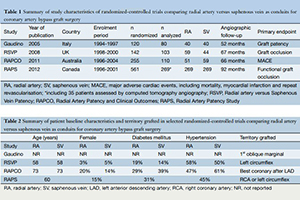A meta-analysis of randomized controlled trials on mid-term angiographic outcomes for radial artery versus saphenous vein in coronary artery bypass graft surgery
Abstract
Background: Currently, saphenous vein (SV) and radial artery (RA) are the most commonly used conduits in combination with the left internal mammary artery for conventional coronary artery bypass graft surgery (CABG). The present meta-analysis aimed to assess the existing evidence from randomized controlled trials (RCTs) to compare the angiographic outcomes of these two conduits at mid-term follow-up.
Methods: Four relevant and updated RCTs with follow-up beyond 3 years were identified using five electronic databases. Angiographic endpoints included complete occlusion, ‘string sign’, graft failure and complete patency.
Results: The incidence of complete occlusion was significantly lower after using RA compared to SV [6.7% vs. 17.2%; odd ratio (OR), 0.36; 95% confidence interval (CI), 0.23-0.58; P<0.0001]. The angiographic ‘string sign’ was significantly more likely to be identified after using RA compared to SV (3.1% vs. 0%; OR, 5.65; 95% CI, 1.21-26.39; P=0.03). Graft failure was significantly lower after RA compared to SV (9.6% vs. 18.8%; OR, 0.47; 95% CI, 0.30-0.72; P=0.0005). Complete graft patency was found to be significantly higher after RA compared to SV (88.6% vs. 75.8%; OR, 3.19; 95% CI, 1.42-7.16; P=0.005).
Conclusions: Results of the present meta-analysis suggest that selected patients with severe, proximal stenosis may have superior angiographic outcomes at mid-term follow-up after using RA compared to SV for CABG. However, RA is associated with a significantly higher incidence of the ‘string sign’. Future studies should aim to collect additional data on symptomatic outcomes.
Cover






